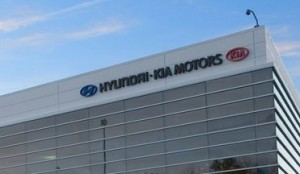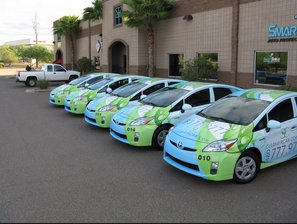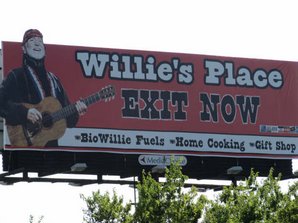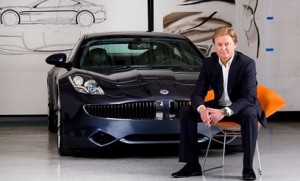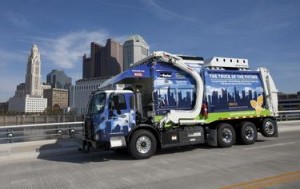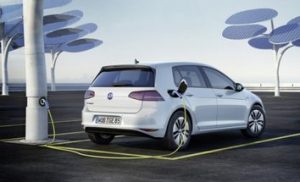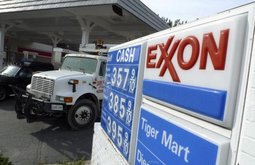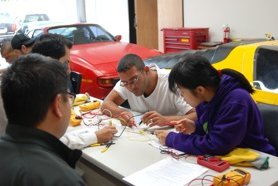 A new job certification category was just released that should be very good news to educators in programs supporting skilled workers servicing alternative fuel vehicles. The National Institute for Automotive Service Excellence (ASE) last week announced the Light Duty Hybrid/Electric Vehicle Specialist (L3) certification category. Service technicians may register starting Dec. 1, 2014, and testing begins in January 2015.
A new job certification category was just released that should be very good news to educators in programs supporting skilled workers servicing alternative fuel vehicles. The National Institute for Automotive Service Excellence (ASE) last week announced the Light Duty Hybrid/Electric Vehicle Specialist (L3) certification category. Service technicians may register starting Dec. 1, 2014, and testing begins in January 2015.
“The new Light Duty Hybrid/Electric Vehicle certification was developed in response to industry requests for an ASE certification for those servicing hybrid vehicles,” said Tim Zilke, ASE President and CEO. “The L3 is the result of years of work by industry specialists from both OEM and Aftermarket segments who came together to develop a certification which encompasses a wide range of hybrid/electric vehicle technology.”
The L3 Certification Test Reference is included as an electronic pop-up during the test. This document identifies the concepts for the hybrid/electric vehicle technology included in the test, and outlines the three common types of hybrid/electric vehicle drive systems, with diagrams shown for each type.
As discussed by educators last February at a day-long workshop, there is a real need for certified service technicians working with hybrids and electric vehicles. Dealers, fleets, and maintenance garages will need to hire more service technicians trained to keep these vehicles running safely and efficiently. As I’ve mentioned many times in this newsletter, and since starting my consulting practice, education and public awareness programs are essential for job creation, vehicle acquisition decisions, and support in legislatures and corporate boards.
It’s good for stakeholders in clean transportation to stay updated on educational resources like the ASE certification. Here’s a list of other resources to keep in mind………
Community-College Based Training
The best training programs out there are coming from community colleges across the country; along with service technicians, training is being delivered for maintenance and repair, fueling stations and infrastructure, other technology courses supporting natural gas, propane autogas, hybrids and electric vehicles, hydrogen, and biofuels. US Dept. of Energy’s Clean Cities Coalition Coordinators are very good to contact for guidance on these resources.
National Alternative Fuels Training Consortium
NAFTC is a nationwide training organization, headquartered at West Virginia University, that develops curricula and conducts more than 20 courses and workshops focusing on alternative fuel and advanced technology vehicles. NAFTC works with US Dept. of Energy (DOE) and Clean Cities, and has 30 national training centers located throughout the US.
Natural Gas Vehicle Institute
NGVI offers natural gas vehicle education, in-house training, and public education forums, technical assistance, and awareness programs for government, utility companies, suppliers, and customers.
Propane Autogas Fleets Safety & Training
Propane Education & Research Council (PERC) offers guidelines for constructing or modifying repair and maintenance garages for propane autogas-fueled vehicles including passenger cars, vans, buses, and trucks. Fleet managers, operators, and private garage owners are given information on basic requirements of a propane autogas-fueled vehicle repair or maintenance garage.
National Fire Protection Association (NFPA)
NPFA is considered by educators to be an essential resource for training programs serving emergency responders. In September, NFPA received a Federal Emergency Management Agency grant to develop NFPA’s Alternate Fuel Vehicle Safety Training. NFPA’s online program will be used to provide free training to the US fire service on safe handling of electric, hybrid, hydrogen fuel cell, compressed natural gas, liquefied natural gas, and liquefied petroleum gas at incidents involving passenger vehicles, trucks, and buses.
The Hybrid Shop
Powered by technology developed by Automotive Research and Design, The Hybrid Shop is an international network of service centers dedicated to bringing scientifically-sound, environmentally friendly, and cost effective repair solutions to owners of hybrid and electric vehicles.
Clean Vehicle Education Foundation
CVEF manages a DOE-funded program that increases awareness of compressed natural gas (CNG) cylinder inspection requirements; and encourages natural gas vehicle owners to periodically have their tanks inspected.
Alternative Fuel Data Center (AFDC)
Check out DOE’s AFDC section on natural gas vehicle maintenance and safety. It’s an educational site covering cylinder inspection, oil-change intervals, ignition systems, and other topics.
SAE International
The Society of Automotive Engineers has working groups that issue standards shaping the way alternative fuel vehicles and the charging/fueling infrastructure are designed and manufactured. Two good sites to research are focused on alternative fuels and vehicle electrification.
Auto Career Development Center (ACDC)
ACDC offers hybrid and electric vehicle technician training through classrooms and other channels such as webinars and DVDs. Its hybrid training goes back to 2000, and electric vehicles were added in 2008.




